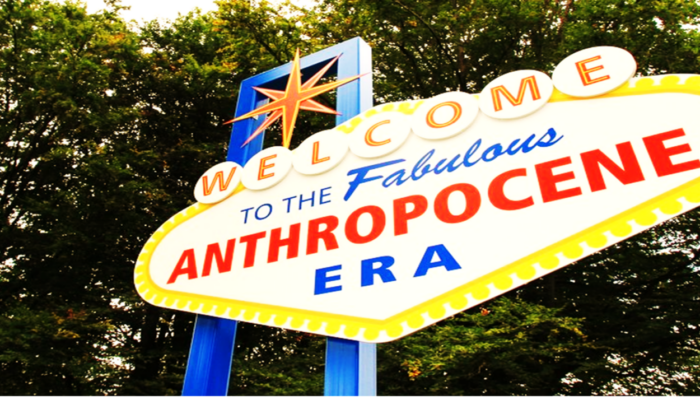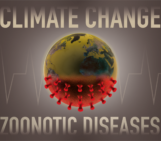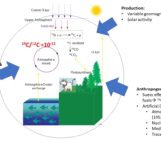
– A debate among scientists and its impact on us
The epoch of humans (and their obvious intervention in the Earth system)
In order to understand what the ‘Anthropocene’ means for us, we need to define first what it actually is. This poses a rather complex question in itself, as various disciplines have given the term rather different and alternative definitions. For instance, the public media uses the term ‘Anthropocene’ to describe the undeniable impact of humans on the environment and in some populist cases even as a synonym for the human-induced climate change that we are currently facing. Whereas social sciences and humanities apply the term with the aim of capturing the essence of “human interaction, culture, institutions, and societies—indeed, the meaning of being human” in raw numbers and data [1-5].
However, the use of the term ‘Anthropocene’, to encompass the concept of all human impacts on the planet Earth, is much broader than it was originally intended [5]. The ‘Anthropocene’ was first introduced by the atmospheric chemist, Paul Crutzen. During a conference held by the Earth System Sciences, Crutzen coined the term ‘Anthropocene’ to express the growing realization within the scientific community, that human impact has become a major external forcing control on the Earth system [6-8]. Since then, more and more geological proof for the human impact on our planet has been unraveled and what began as a realization of few became the general consensus among geoscientists and many other scientific communities:
Human activity has become a major driving force in the Earth System and it already influences geological processes.
If apparently everyone agrees, that we have entered a time in which humans significantly control our planet, where is the problem?

Figure 1: Floodplain deposits in the National Park Donau-Auen (located between Vienna, Austria, and Bratislava, Slovakia) containing sediments of anthropogenic origin, such as plastic and a pot. (c) Photo credit: Diana Hatzenbühler
The ‘Anthropocene’ – An epochal debate about time and humankind.
The term ‘Anthropocene’ has sparked a lively debate about whether it is appropriate to introduce a new geological time period to reflect the accelerating impact of human activity on the Earth system. Such a debate may seem to be more of a specialized nature, but it perfectly illustrates how scientific disputes work and how the outcome of seemingly “quibble” discussions (such as some already passed beginning of a new time) can have a direct influence on us as individuals and as a society.
The official discussion of the ‘Anthropocene’ began a few years after the introduction of this term in the scientific community. The idea of a new epoch quickly gained many followers resulting in the initiation of the official process of declaring a new geological time unit.
The resolution of time
For geologists, such time units are used to describe Earth’s history (- the “Geologic Time Scale”), and their beginning is marked by important events in our planet’s history, such as the rise of life or fall of life forms. This story is recorded in geological archives, namely rocks and sediment. Geoscientists read these archives and look for past evidence, so-called “stratigraphic signals”, which give them information about e.g. past climatic conditions or mass extinction events. There are different levels of resolution for these units and for geologists ‘epochs’ are among the finer subdivisions mostly being used to describe the more recent history of Earth (the last 66.5 million years) with the Holocene being the youngest epoch in which we are currently living. This “more recent” history of Earth seemed to be well enough understood and naturally, there were several opponents of the idea to change this ‘running system” by introducing a new time unit.
Are humans making history?
In 2007, the upper instance of geoscientists defining global time units, the Stratigraphic Commission of the Geological Society of London, conducted a preliminary analysis [9] which declared that there should be enough geological evidence for a new time unit, the potential ‘Anthropocene’. The commission emphasized that the key idea of this geological time interval is that “human modification of natural systems has become predominant” [10] and that it is not only locally or regionally significant, but has a worldwide synchronous base. Following this call, a working group comprising geoscientists and experts from fields such as international law, philosophy, history, oceanography, geography, and archaeology was formed to work on its formalization. As soon as the first publications started using the term ‘Anthropocene’ appeared, opposing voices and letters of opposed positions began to emerge.
Holocene vs. ‘Anthropocene’: Similar, yet distinct, but different.
There are two main sides in this debate: one advocating for the new geological epoch ‘Anthropocene’, and one arguing for its integration into the already existing epoch, the Holocene.

Figure 2: AI-generated illustrations picturing “the Holocene Epoch” (left), and ” the Anthropocene Epoch” (right). © Microsoft/Bing.
The Holocene side – “We already have a ‘human epoch’, why another one?”
The ‘Holocene’ epoch can be roughly translated as ‘entirely recent’ and covers the last 11,700 years. It comprises the most recent interglacial interval and coincides with the effects of modern humans on planet Earth, such as the agricultural revolution and every known major civilization in human history (see [11] and references therein). This is for example reflected in the CO2 rise in the atmosphere [12], heavy metal contamination from smelting and mines [13], or mass extinctions [14] throughout the Holocene. From a geological point of view, the current rise we see now could be interpreted as a very brief event (instant to thousands of years) in Earth’s history, being too short-lived to account for an entirely new epoch. Another argument against the ‘Anthropocene’ is the use of many human-generated artifacts to characterize this epoch, e.g. plastics, bricks, or concrete (also called ‘technofossils’), or radiogenic nuclides generated during the nuclear weapon testing in the 1960s. These materials occur exclusively in the last couple of thousands of years, which makes a comparison to time units millions or billions of years ago questionable or even impossible. Furthermore, it can not be said for sure if these new signals are geologically viable to be compared to time units in a few million years, or if they will vanish together with humanity one day [15].
Finally, the term ‘Anthropocene’ has become emotionally charged as it is in several ways related to the current climate crisis. Arguing for such an epoch by stressing the possible impact on politics (i.e. climate policies) and the responsibility to do take measures to fight climate change, would link geological consequences to societal actions and therefore involve a political dimension [16]. This argumentation would undermine the neutrality of science by going beyond the purely geoscientific nature of the concept and does not justify the introduction of a new epoch.
The ‘Anthropocene’ side – “Human impact is hitting like an atomic bomb, literally.”
The ‘Anthropocene’ is currently characterized by an exceptionally rapid rate of change in the Earth System [17, 18]. Until the 18th century, this interference in the environment has spread only locally. In the mid-20th century, we can observe a global, approximately synchronous upward trend in a great number of signals associated with geological proxies and stratigraphic signals, e.g. chemical disruption to the natural cycles of carbon and nitrogen, unprecedented invasions of species across the globe, as well as with the global economy, energy and resource use, population growth, and industrialization [19]. Despite its short duration as a hypothetical geological time unit, its characteristics are geologically long-lasting and some even effectively irreversible [9] making them meaningful and comparable to other intervals of geological time [5].
Finally, the political and societal impact, which could be regarded as too subjective for a scientific decision-making process point of view, is actually emerging as an important branch of natural sciences. One prominent example is the discussions about genetic engineering; being able to do or not do something requires dealing with the consequences as well. The same premise will inevitably have to apply to many other fields of science, calling for the integration of ethics in research and understanding the role of science for humankind and politics.
Why would a normal person care about the geological definition of the ‘Anthropocene’?
The above-mentioned “normal person” refers to the average citizen of Western society, and as such, we all will be affected by the outcome of the debate through other disciplines which might start a chain reaction.
From an ethical and historical point of view, the ‘Anthropocene’ would define the position of humankind in the history and future of Earth. It would establish the human impact a fact learned from schoolbooks and demonstrate the global interconnection between human-made non-natural systems, such as the global economy, and the Earth System. As we must learn about our human history, about the mistakes, the progress, and the steps leading to where we are now as a society, we need to understand our impact on our Earth and use the insights and predictions from science to avoid wrongdoing and to actively steer the course of our future.
Similar to other disciplines from natural and social sciences, the proclamation of a new finding, or its “definition”, marks one step on the way to human progress and insight. When correctly applied, such knowledge has the power to prevent fatal developments and steer chain reactions in a more fortunate direction, as it was done with the first global climate protection law in 1962, namely the treaty on the prohibition of nuclear weapons [20].

Figure 3: Aug. 5, 1963: The first Limited Test Ban Treaty (LTBT) was a trilateral agreement between the U.S., U.S.S.R., and U.K., stopping atmospheric, underwater, and outer space nuclear tests. (c) Left: lcnp.org, right: National Archives and Records Administration
In this context, such a formal, scientific definition could form the basis for future legislation: a geological interpretation would be seen as a notorious fact and could form the foundation for international law and court cases. It would have the potential to enforce, for example, climate change mitigation or sustainable resource management. By declaring a new epoch, which acknowledges the anthropogenic impact as an undeniable and “world”-changing fact, it has the power to form a complementary scientific fact to annual assessments by the Intergovernmental Panel on Climate Change (IPCC), which presents regular assessments of the scientific basis of climate change, its impacts and future risks, and necessary political decisions. One prominent implementation of such an approach was already shown by the “Urgenda Climate Case” against the Dutch Government. It has formed the first official case in which citizens established that their government has a legal duty to prevent dangerous climate change by deploying scientific documents in the impeachment proceedings, in this case, the IGCP report [21].
To some such discussion may seem rather mundane, as the answer will not solve the urgent problems we are facing nowadays. However, it has the clear potential to be one step among other important ones, which can lead to answers. The debate on the ‘Anthropocene’ is not about whether the human impact is big enough to be seen in the geological record and have an impact on the Earth System. Instead, it revolves around assessing the implications, consequences, and responsibilities associated with this recognition. By officially defining the impact we have as humans and naming it, we push the spotlight on the responsibility we bear towards our environment, our planet, and future generations. This goes beyond awareness of our profound impact as a society or as an individual. Instead, it stresses our obligation to bear and reduce the consequences for it, namely a changing Earth System.
References [1] Palsson, G., Szerszynski, B., et al. (2013). Reconceptualizing the ‘Anthropos’ in the Anthropocene: Integrating the social sciences and humanities in global environmental change research. Environmental Science & Policy, 28, p.10. https://doi.org/10.1016/j.envsci.2012.11.004 [2] Ellis, E. C. (2018). Anthropocene: A very short introduction (183 pp.). Oxford, UK: Oxford University Press. [3] Horn, E., & Bergthaller, H. (2020). The Anthropocene: Key issues for the humanities (192 pp.). Abingdon, UK: Routledge. [4] Thomas, J. A., Williams, M., et al. (2020). The Anthropocene: A multidisciplinary approach (288 pp.). Cambridge, UK: Polity Press. [5] Zalasiewicz, J., Waters, C.N., Ellis, E.C., Head, M.J., Vidas, D., Steffen, W., Thomas, J.A., Horn, E., Summerhayes, C.P., et al. (2021). The Anthropocene: Comparing Its Meaning in Geology (Chronostratigraphy) with Conceptual Approaches Arising in Other Disciplines. Earths Future 9. https://doi.org/10.1029/2020EF001896 [6] Steffen, W., Richardson, K., et al. (2020). The emergence and evolution of Earth System science. Nature Reviews Earth and Environment, 1, 54–63. https://doi.org/10.1038/s43017-019-0005-6 [7] Crutzen, P. J. (2002). Geology of mankind. Nature, 415(January), 23. https://doi.org/10.1007/978-3-319-27460-7_10 [8] Crutzen, P. J., & Stoermer, E. F. (2000). The “Anthropocene”. IGBP Global Change Newsletter, 41, 17–18. [9] Zalasiewicz, J., Williams, M., et al. (2008). Are we living in the Anthropocene? Geological Society of America Today, 18(2), 4–8. https://doi.org/10.1130/GSAT01802A.1 [10] SQS. (2009). International Commission on Stratigraphy, Subcommission on Quaternary Stratigraphy (SQS), Annual Report 2009. http:// quaternary.stratigraphy.org/wp-content/uploads/2018/04/SQSAnnual-report09.doc [11] Ruddiman, W.F., 2003. The Anthropogenic Greenhouse Era Began Thousands of Years Ago. Clim. Change 61, 261–293. [12] Waters, C.N., Zalasiewicz, J., Summerhayes, C., et al., 2016. The Anthropocene is functionally and stratigraphically distinct from the Holocene. Science 351, a2622. https://doi.org/10.1126/science.aad2622 [13] Wagreich, M., Draganits, E., 2018. Early mining and smelting lead anomalies in geological archives as potential stratigraphic markers for the base of an early Anthropocene. Anthr. Rev. 5, 177–201. [14] Ceballos, G., Ehrlich, P., et al. (2015). Accelerated modern human-induced species losses: Entering the sixth mass extinction. Science Advances, 1(5), e1400253. https://doi.org/10.1126/sciadv.1400253 [15] Zalasiewicz, J., Waters, C.N., Wolfe, A.P., et al., 2017. Making the case for a formal Anthropocene Epoch: an analysis of ongoing critiques. Newsl. Stratigr. 50, 205–226. https://doi.org/10.1127/nos/2017/0385 [16] Finney, S. C., & Edwards, L. E. (2016). The “Anthropocene” epoch: Scientific decision or political statement? Geological Society of America Today, 26(2–3), 4–10. https://doi.org/10.1130/GSATG270A.1 [17] Syvitski, J., Waters, C. N., et al. (2020). Extraordinary human energy consumption and resultant geological impacts beginning around 1950 CE initiated the proposed Anthropocene Epoch. Communications Earth & Environment, 1, 32. https://doi.org/10.1038/s43247-020-00029-y [18] Head, M. J. (2019). Formal subdivision of the Quaternary System/Period: Present status and future directions. Quaternary International, 500, 32–51. https://doi.org/10.1016/j.quaint.2019.05.018 [19] Steffen, W., Crutzen, P. J., et al. (2007). The Anthropocene: Are humans now overwhelming the great forces of Nature? Ambio, 36, 614–621. https://doi.org/10.1579/0044-7447(2007)36[614:TAAHNO]2.0.CO;2 [20] https://www.un.org/disarmament/wmd/nuclear/tpnw/; accessed on 09.10.2022 [21] https://www.urgenda.nl/en/themas/climate-case/; accessed on 10.12.2022
This blog was edited by the CL editorial board.




Kurtl
Awesome